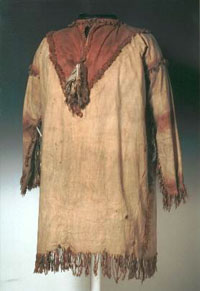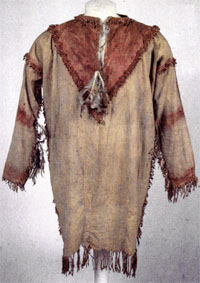
Home :
History :
Images :
The Glasgow Ghost Shirt
The Glasgow Ghost Shirt
 The so-called "Glasgow Ghost Shirt" was discovered by a Cherokee Indian named John Earl during a visit to a museum in Glasgow, Scotland. The shirt had been in the Kelvingrove Museum there since 1892 when George C. Crager, a member of the Buffalo Bill Wild West Show, sold it and several other items to the curator. This shirt is believed to have been taken from one of the 146 victims of the massacre at Wounded Knee in 1890. It is pierced in several places with bullet holes, and slight brown stains still mar the torn cloth. This shirt has been returned to the Lakota people, and replaced by a new Ghost Dance Shirt made in 1998 by Marcella Le Beau, greatgrandaughter of one of the survivors of the massacre at Wounded Knee.
The so-called "Glasgow Ghost Shirt" was discovered by a Cherokee Indian named John Earl during a visit to a museum in Glasgow, Scotland. The shirt had been in the Kelvingrove Museum there since 1892 when George C. Crager, a member of the Buffalo Bill Wild West Show, sold it and several other items to the curator. This shirt is believed to have been taken from one of the 146 victims of the massacre at Wounded Knee in 1890. It is pierced in several places with bullet holes, and slight brown stains still mar the torn cloth. This shirt has been returned to the Lakota people, and replaced by a new Ghost Dance Shirt made in 1998 by Marcella Le Beau, greatgrandaughter of one of the survivors of the massacre at Wounded Knee.
The bloodstains on the plain cotton shirt are barely visible anymore. The holes created by the fatal bullets almost look as if they could have occured naturally with the passage of time. The Raven, Owl and Eagle feathers hanging from the neck of the off-white tunic are tattered and ragged.
A Ghost Shirt was a shirt or dress worn by someone participating in a Ghost Dance. The shirt was usually made of white cotton cloth, although a few were made of leather. Blue, yellow and red pigment was used to paint stars, moons, birds and other designs on the shirt. Feathers, especially those of birds sacred to the wearer, and buffalo fur often adorned the shirts as well. Each wearer decorated his or her shirt with symbols from personal visions or items of power.
 While many tribes wore the ghost shirts and took part in the dance, only the Lakota believed that the clothing would protect them from the bullets of the white man. One of the songs sung at the Lakota ceremonies celebrated the special protection of the Ghost Shirt:
"Verily, I have given you my strength, Says the Father, says the Father. The shirt will cause you to live, Says the Father, says the Father."
Kicking Bear, a Miniconjou Teton, made a pilgrimage to Nevada to learn about this new "religion". He returned to his people and together with Short Bull, another Miniconjou mystic, gave the religion a unique interpretation, choosing to disregard Wovoka's anti-violence and emphasizing the eventual elimination of the white people. Short Bull told his followers that if surrounded by white soldiers, those wearing the ghost shirts should sing a certain song to make the soldiers fall down dead. Short Bull continued by stating "you must know this, that all the soldiers and that race will be dead."
While many tribes wore the ghost shirts and took part in the dance, only the Lakota believed that the clothing would protect them from the bullets of the white man. One of the songs sung at the Lakota ceremonies celebrated the special protection of the Ghost Shirt:
"Verily, I have given you my strength, Says the Father, says the Father. The shirt will cause you to live, Says the Father, says the Father."
Kicking Bear, a Miniconjou Teton, made a pilgrimage to Nevada to learn about this new "religion". He returned to his people and together with Short Bull, another Miniconjou mystic, gave the religion a unique interpretation, choosing to disregard Wovoka's anti-violence and emphasizing the eventual elimination of the white people. Short Bull told his followers that if surrounded by white soldiers, those wearing the ghost shirts should sing a certain song to make the soldiers fall down dead. Short Bull continued by stating "you must know this, that all the soldiers and that race will be dead."
Ghost Dance shirts are objects of power to the wearer, and sacred to the tribes. While some shirts are displayed in museums, this practice isn't one of universal acceptance among the families of those who participated in the Ghost Dance.
See Also:
The Role of Ghost Shirts & Ghost Dance Dresses (James Mooney)

